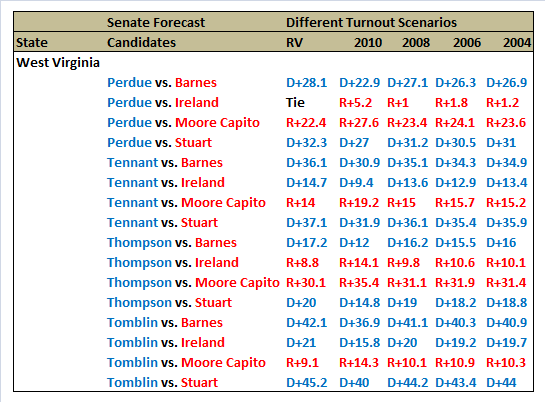crossposted at StochasticDemocracy and DailyKos
These are the Labor Day election forecasts of Stochastic Democracy, in collaboration with Professor Wang of the Princeton Election Consortium. We have launched a new Election Forecasting System for House, Senate and Gubernatorial Elections and for tracking the Generic Ballot.
But before we discuss the forecasts in more detail, let me first get out of the way who we are and why you should listen to what we’re predicting:
Who we are (quoted from the FAQ at our site):
The team consists of David Shor, Harry Enten, and Rasmus Pianowski. David is a Math student currently visiting Princeton University as a Visiting Graduate Student. Harry is an undergraduate at Dartmouth and an intern at Pollster.com. Rasmus (that’s me) is a freshman at University of Hamburg, he has done political consulting and Media Outreach work for Montana congressional candidate Tyler Gernant.
The site is closely affiliated to Professor Wang’s Princeton Election Consortium.
Why you should listen to us
We have an outstanding track record.
In 2008, we correctly predicted the results of 49 of the 50 states in the Presidential Election, missing only Indiana (where we predicted that Obama had a 48% chance to win). We correctly predicted every single Senate and Gubernatorial election, and were off on the national popular vote for President by only 0.08%..
We also predicted that Obama would get 364 Electoral Votes, he ended up with 365 Electoral Votes.
In 2009, we correctly predicted the outcome of the 2009 Israeli Knesset election as well as 4 of the 5 notoriously hard to predict 2009 off-year elections- Pollster.com got only 2 correct, 538.com didn’t even put up predictions.
And we have a solid forecasting methodology that combines advanced statistical techniques with a huge polling database- and we do account for House Effects, so that you can be sure that our ratings aren’t swayed by Republican-leaning Rasmussen Reports polls too much.
Now on to the Forecasts.
Let me get out the bad news, and there is a lot of bad news, quickly:
The GOP is favored to take over the House, several Senate seats and Governorships.
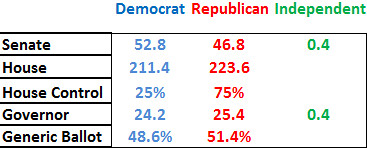
For a complete list of election results, please visit Stochastic Democracy, here you’ll only find an analysis of several important races, maps and tables with results for select races.
Senate
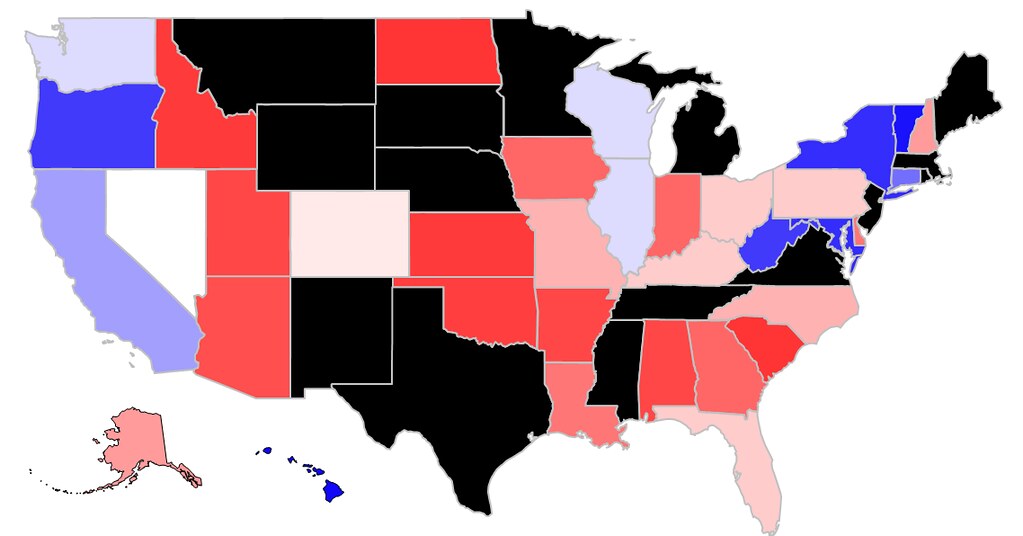
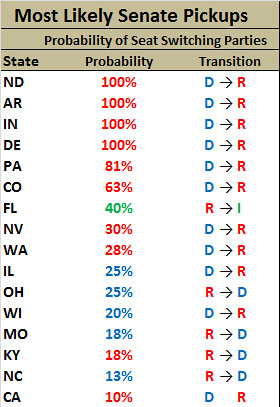
As you can see, things look rather badly for the Democrats on the Senate front. While Republicans seem like relatively heavy underdogs to get a majority in the Senate, they at least will pick up several seats.
Arkansas, North Dakota, Indiana and Delaware are gone. With deficits of more than 15% in even the closest of these four races, it doesn’t make much sense to keep fighting except for helping down-ballot races.
In Pennsylvania, Joe Sestak has a fighting chance to mount yet another comeback, but so far his campaign hasn’t really taken off and with less than two months to go until the election he’s down against Pat Toomey by a bit less than 6%.
Colorado is close right now, even though the Republican candidate Ken Buck is ahead by a bit more than three points right now. The infighting among Colorado Conservatives in the Gubernatorial race might help Bennet to catch up.
In Florida the race is all but officially between incumbent Governor Charlie Crist, the Republican-turned Independent, and Tea Party favorite, Marco Rubio. The Democratic candidate Kendrick Meek has just about a 1 in 200 chance to win, while Rubio maintains a 4.5 point-advantage over Crist. The race is so unstable though that Crist can easily come back- or collapse.
In all other races, the incumbent party is currently favored (more or less) to retain their seats. For the Republicans, that means that Rob Portman (OH), Roy Blunt (MO), Rand Paul (KY), Richard Burr (NC) and the winner of the New Hampshire GOP primary (probably Kelly Ayotte) will more likely than not win.
The likely Democratic winners include Harry Reid (NV), Alexi Gianoullias (IL), Barbara Boxer (CA), Russ Feingold (WI)and Joe Manchin (WV), who is so heavily favored to retain the late Senator Byrd’s seat that this race doesn’t show up in the ‘most likely pickups’ table. On the other hand, Gianoullias, Reid and Feingold are all in races that could still go either way, even though they’re favored over their respective opponents right now.
Gubernatorial races
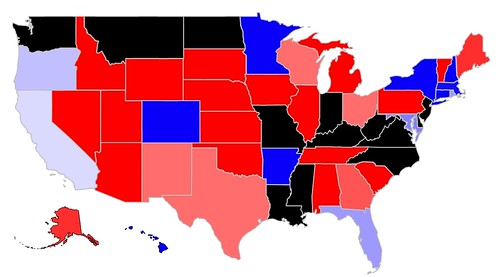
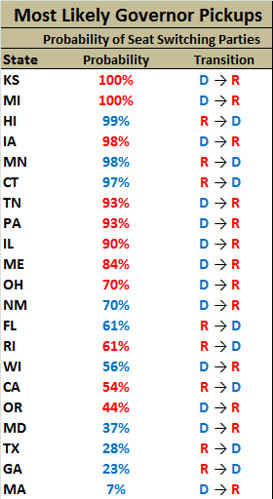
In the gubernatorial races, there are a few more highlights for Democrats, even though the bottom line looks rather bleak for Democrats here as well.
We are almost sure to lose six Governorships to the Republicans: In Kansas, Michigan, Iowa, Tennessee, Pennsylvania and Illinois. In every of those races except for Illinois, the Republican candidate is ahead by double digits, and most likely less than two months won’t be enough to close that gap.
On the bright side, we’re also almost certain to pick up the Governorships of Hawaii, Minnesota and Connecticut.
Maine is a race that doesn’t qualify as a ‘sure loss’ yet, but it doesn’t look good for Democrats, as Republican Paul LePage is leading Democrat Libby Mitchell by more than 8 points.
In the close battleground races it currently looks like Republican John Kasich is going to unseat incumbent Governor Ted Strickland of Ohio, Kasich is currently ahead by 4 points. The same could be said of New Mexico‘s gubernatorial race, where Republican Susana Martinez is favored to beat the Democratic Lieutenant Governor Diane Denish. Both of these races are close enough for Strickland and Denish to mount a comeback though.
Meanwhile, Democrats look like slight favorites in the gubernatorial elections of Florida, where Democrat Alex Sink leads the scandal-ridden Republican nominee Rick Scott, and in Rhode Island, where Democrat Frank Caprio is a slight favorite to win the governorship, edging former independent U.S. Senator Lincoln Chaffee. The Republican candidate is far behind.
Meanwhile, the true Toss-ups right now are in California (Brown vs. Whitman), Wisconsin (Barrett vs. Walker), and Oregon (Kitzhaber vs. Dudley). None of these races have a clear favorite right now, even though Barrett, Brown and Dudley would be slight favorites if the election was held today.
Democratic Governor Martin O’Malley (MD) and Republican Governor Rick Perry (TX)are both moderately favored to win their re-election bids against strong challengers, respectively former Governor Bob Ehrlich and Houston Mayor Bill White.
Incumbent party-candidates in New Hampshire (Lynch), Georgia (Deal), Massachusetts (Patrick) and in all races that aren’t listed here are favored to win their elections.
U.S. House


I don’t have enough space here to talk about all the interesting races as in the Senate and Governor sections, so let me just highlight the results of a couple of races that I know are dear to the netroots and of some especially close races:
In Florida-08 (Grayson-D), Alan Grayson is projected to lose to his challenger, Dan Webster, by 7.5%. He still has about a 25% chance to win reelection. Keep in mind that our model does not directly look at fundraising (it does look at Cook ratings though, and Cook does include fundraising in his ratings)- and Grayson has a gigantic warchest.
In Illinois-10 (open-R) Dan Seals is a slight favorite to finally become a U.S. Representative after twice unsuccessfully running against Mark Kirk.
In New York-20 (Murphy-D), Scott Murphy, who was elected with a strong Kossack phonebanking drive in the 2009 special election to replace Senator Gillibrand, looks like a slight favorite to win reelection. Bill Owens in NY-23 is a slight underdog though.
In Virginia-5 (Periello-D), red-district Progressive Tom Periello will almost certainly lose reelection.
In Idaho-1 (Minnick-D), the probably most conservative House Democrat Walt Minnick is projected to be a slight underdog in his reelection bid. You shouldn’t take this number too seriously though: This race is extreme. Minnick was, and the model can’t incorporate this, endorsed by the Tea Party Express and the Chamber of Commerce and praised by the Club for Growth, and the NRCC has already pulled resources from this district in the light of polls that show Minnick far ahead of his Republican opponent. Expect this number to shift as more polls come in, but right now our model isn’t convinced of Minnick’s staying power, as McCain won the district by a 61-35 margin in the 2008 Presidential Election while Minnick just barely beat a disliked Republican incumbent who won only 60% of his primary vote after winning a six-way GOP primary with 26% of the vote in 2006.
Races on knife’s edge: Here you can really make a difference
Julie Lassa (D) vs. Sean Duffy (R) (WI-07, Obey retiring)
Rep. Gerry Connoly (D) vs. Keith Firmian (R) (VA-11)
Rep. Phil Hare (D) vs. Robby Schilling (R) (IL-17)
Colleen Hanabusa (D) (likely) vs. Rep. Charles Djou (R) (HI-01)
Rep. Gabrielle Giffords (D) vs. Jesse Kelly (R) (AZ-08)
All of these 5 races are so close that every additional volunteer or donor might tip the race.
Summary:
Again, the bottom line isn’t pretty: The Democrats are likely to lose the House, several Senate seats and more Governorships than they will pick up.
Talking about continuing the gains that Democrats made in 2006 and 2008 is irrational now- what we can all do is pick a few campaigns and invest a lot of our time and put our best efforts into limiting our losses.
What the DCCC does– cutting incumbents that can’t win loose, might be a good strategy for private volunteers and donors as well.


